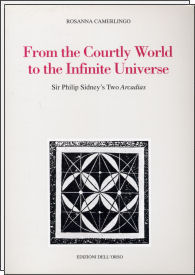| The
court and a new infinite universe are the respective protagonists of Sir
Philip Sidney's first and second Arcadia. If the Old Arcadia
(1579) humorously desecrates the figure of the sovereign and the hierarchical
order irradiating from him, the New Arcadia (1584) is a grandioseattempt
to "reform" the political and moral dilemma portrayed in the
first romance. The eliocentric cosmos of Copernicus and the infinite universe
of Giordano Bruno were for Sidney compatible with his idea of a new social,
political and moral order. Written in an age when astronomical and geographical
discoveries were definitely tearing apart the centuries- old Aristotelian
cosmos, the two Arcadias testify to Sidney's dissatisfaction
with the old closed Ptolemaic universe and to his interest in the new
forms of knowledge which were opening up the path to the scientific thought
of the "new philosophy". The transition from the closed world
of the court of the Old Arcadia to the infinite universe of the
New Arcadia signals the crisis of humanism and the rise of a
new and modern notion of literature. The figure of Sidney emerging from
this book is not the canonical sigure as the humanistic Christian knight.
Fron an attentive and close analysis of Sidney's works, this book rather
extrapolates the portrait of an exuberant and rebellious aristocrat, enthusiastic
supporter of the heterodox and anti-aristotelian ideas which were circulating
in late sixteenth-century Elisabethan London.
|
TABLE
OF CONTENTS
Acknowledgements
Introduction
The Arcadian and their Critcs
The Parts and the Whole: Polemics on then Chivalric Romance
Genres and Politics: the Old Arcadia
Dark Plotting in Arcadia
«Wonders are no wonders in a wonderful subject»: the New Arcadia
«Natura est deus in rebus»
«Heroycall effects»
Bibliography
Index
|


Rosanna Camerlingo
FROM THE COURTLY WORLD TO THE INFINITE UNIVERSE
editore DELL'ORSO
edizione 1993
pagine 250
formato 15x21
brossura con alette
tempo medio evasione ordine
a richiesta
16.00 €
16.00 €
ISBN : 88-7694-147-9
EAN :
|
|